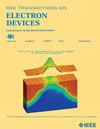Design Optimization of Flip FET Standard Cells With Dual-Sided Pins for Ultimate Scaling
IF 2.9
2区 工程技术
Q2 ENGINEERING, ELECTRICAL & ELECTRONIC
引用次数: 0
Abstract
Recently, we proposed a novel transistor architecture for 3-D stacked FETs called Flip FET (FFET), featuring N/P transistors back-to-back stacked and dualsided interconnects. With dual-sided power rails and signal tracks, FFET can achieve an aggressive 2.5 T cell height. As a tradeoff, the complex structure and limited numbers of M0 tracks could limit the standard cell design. As a solution, multiple innovations were introduced and examined in this work. Based on an advanced node design rule, several unique building blocks in FFET such as drain merge (DM), gate merge (GM), field DM (FDM), and buried signal track (BST) were investigated. Other key design concepts of multi-row, split gate (SG), and dummy gate (DG) insertion were also carefully studied, delivering around 35.6% area reduction compared with 3 T CFET. Furthermore, the symmetric design of FFET has unique superiority over CFET thanks to the separate N/P logic on two sides of the wafer and their connections using DM and GM. New routing scheme with dual-sided output pins on both wafer frontside (FS) and backside (BS) was proposed for the first time. Finally, we conducted a comprehensive evaluation on complex cell design, taking AOI22 as an example. New strategies were proposed and examined. The FDM design is identified as the best, outperforming the BST and DG design by 1.93% and 5.13% for the transition delay.具有双面引脚的翻转场效应管标准电池的设计优化,以实现最终的缩放
最近,我们提出了一种新的用于3-D堆叠FET的晶体管结构,称为翻转FET (FFET),具有N/P晶体管背对背堆叠和双面互连。利用双面电源轨和信号轨,FFET可以达到2.5 T的电池高度。作为权衡,复杂的结构和有限数量的M0轨道可能会限制标准电池的设计。作为解决方案,本研究引入并研究了多种创新方法。基于一种先进的节点设计规则,研究了FFET中几种独特的组成模块,如漏极合并(DM)、栅极合并(GM)、场域DM (FDM)和埋地信号轨道(BST)。我们还仔细研究了多排、分栅(SG)和假栅(DG)插入等其他关键设计概念,与3t CFET相比,它们的面积减少了35.6%左右。此外,FFET的对称设计与cefet相比具有独特的优势,这是因为它们在晶圆的两侧具有独立的N/P逻辑,并且它们的连接使用DM和GM。首次提出了在晶圆的正面(FS)和背面(BS)都有双面输出引脚的新布线方案。最后,我们以AOI22为例,对复杂电池的设计进行了综合评价。提出并审查了新的战略。FDM设计被认为是最好的,在过渡延迟方面比BST和DG设计分别高出1.93%和5.13%。
本文章由计算机程序翻译,如有差异,请以英文原文为准。
求助全文
约1分钟内获得全文
求助全文
来源期刊

IEEE Transactions on Electron Devices
工程技术-工程:电子与电气
CiteScore
5.80
自引率
16.10%
发文量
937
审稿时长
3.8 months
期刊介绍:
IEEE Transactions on Electron Devices publishes original and significant contributions relating to the theory, modeling, design, performance and reliability of electron and ion integrated circuit devices and interconnects, involving insulators, metals, organic materials, micro-plasmas, semiconductors, quantum-effect structures, vacuum devices, and emerging materials with applications in bioelectronics, biomedical electronics, computation, communications, displays, microelectromechanics, imaging, micro-actuators, nanoelectronics, optoelectronics, photovoltaics, power ICs and micro-sensors. Tutorial and review papers on these subjects are also published and occasional special issues appear to present a collection of papers which treat particular areas in more depth and breadth.
 求助内容:
求助内容: 应助结果提醒方式:
应助结果提醒方式:


